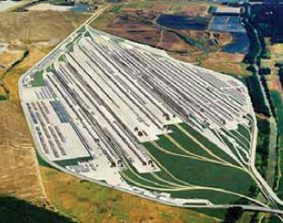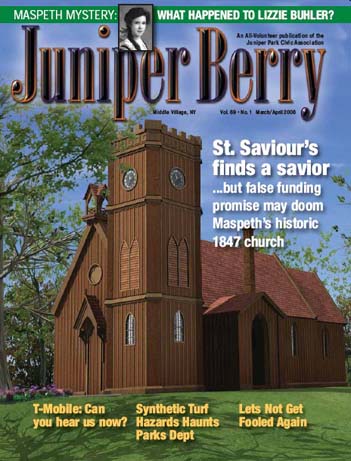On January 30, 2008 the NYC Council introduced Resolution 1220 calling upon the Mayor of New York, the Port Authority of New York and New Jersey and the Federal Government to approve and institute a plan for the construction of the Cross Harbor Freight Tunnel. It is not my intention to re-argue that this is an ill-conceived and misguided plan to spend taxpayer money on unwarranted construction solely to provide jobs for the supporters’ constituents and not in the best interest of New York City or the many neighborhoods that would be drastically impacted by the long term construction and the permanent consequences of heavy rail and truck traffic. However, I must provide some clarity to the question of the “Tunnel”.
This resolution is a litany of falsehoods, mainly being promises of pollution reduction and job creation which can be achieved through other means. Here again Representative Jerrold Nadler has been instrumental in having another group of misinformed elected officials sing the cross-harbor tunnel song. It is interesting to note that none of the councilpersons signing onto the resolution have any academic or transportation industry experience in their background profile, and you would think that a resolution of this nature would have been initiated by the Transportation Committee Chairman, John Liu, not Lewis A. Fidler, Chairperson of the Youth Services Committee, representing the 46th council district in Brooklyn.
Perhaps the sponsors of this resolution don’t realize that the other end of the tunnel would be in Jersey City, NJ and it is a very un-popular subject there. In 2004, the Jersey Journal quoted Jersey City Mayor Glenn D. Cunningham saying, “We do not need to be a garbage transfer locality for the city of New York.”
While the creation of jobs and protecting the environment are necessary and noble causes for governments, these goals can be accomplished without the “Tunnel” construction. Our governments could establish thousands of jobs that would enhance the rail infrastructure, provide new rail-beds, install highway type sound barriers that would also act as security fencing where needed, remove grade crossings in urban areas and re-establish passenger service on the Bay Ridge Line which would require several new stations along the way. Upgrading the Belt Parkway between the Verrazano Bridge and JFK Airport to federal interstate standards is easy and doable – and would result in more jobs and less truck pollution in Brooklyn and Queens.
The twenty-seven sponsors of resolution 1220 should use their collective influence to press for incremental transportation improvements that in the end will provide jobs, actually reduce pollution from vehicular fumes and abate traffic congestion. Why doesn’t the NYC Council Transportation Committee question why the NYCDOT has not conducted an analysis of their traffic signal system that causes needless and environmentally harmful idling of vehicles in some neighborhoods almost at every corner? The savings in environmental pollution would definitely far out-weigh the savings from the pollution of a million trucks a year, which is mathematically reduced to less than 12 trucks per hour for the City of New York. But it would provide few jobs in comparison to the “Tunnel”. So the question is – is it jobs or is it pollution? The answer is to do all of the above and leave the “Tunnel” on the drawing board.
It is about time the City of New York used the facilities that are readily available to move freight from New Jersey to New York, such as the 65th Street float bridges at the end of the Bay Ridge Line. The bridges have been idle during the seven years of the Bloomberg Administration. In addition, the city should concentrate on having several miles of working waterfront in the Sunset Park-Bay Ridge area with rail access for off-loading container ships. This would mean yet more jobs.
In conclusion, I note that not much thought went into resolution 1220, which is simply “it sounds good to my constituents, put my name on it” politics at its worst.
_______________________________________________
Res. No. 1220
Resolution calling upon the Mayor of the City of New York, the Port Authority of New York and New Jersey and the Federal government to approve and institute a plan for the construction of the Cross Harbor Freight Tunnel.
By Council Members Fidler, Rivera, Comrie, DeBlasio, Oddo, Arroyo, Reyna, Barron, Eugene, Gennaro, Gentile, Ignizio, James, Koppell, Lappin, Mark-Viverito, Martinez, Foster, Gerson, McMahon, Sanders Jr., Seabrook, Stewart, White Jr., Yassky, Dilan and Weprin
Whereas, The construction of the Cross Harbor Freight Tunnel, spanning the New York
Harbor, would, according to the Pratt Center for Community Development, take approximately one million truck runs off the streets of New York City every year; and
Whereas, The most noxious vehicular traffic in the City comes from trucks; and
Whereas, Many trucks occupy the same space as approximately three to four passenger vehicles, emit considerably more pollution and are responsible for the vast majority of wear and tear on our existing roadways and bridges; and
Whereas, According to an article published in The New York Sun on October 18, 2007, a grant of $100 million from the Federal government to study the feasibility of building the Cross Harbor Freight Tunnel is already in place and it is expected that a considerable portion of the estimated multi-billion dollar cost will come from the Federal government; and
Whereas, According to Move NY & NJ, a transportation advocacy group, numerous other benefits of the Cross Harbor Tunnel include the creation of 23,000 permanent long-term jobs and 6,500 construction jobs, savings in road repair and maintenance, and the creation of a third arterial to bring freight into the City; and
Whereas, The reduced number of trucks traveling through the City resulting from construction of the Cross Harbor Tunnel would bring with it the innumerable environmental, ecological and health benefits of cleaner air; and
Whereas, Sound dampening materials and other ameliorating landscaping can be used along the right of way to ensure that neighboring communities are not adversely affected by increased use of the train line; and
Whereas, There are a number of possible unloading areas along the right of way, including, but not limited to, the Brooklyn Terminal Market, Maspeth, and the East New York Industrial Park, that would enjoy the economic benefits associated with the unloading of the rail freight; and
Whereas, The use of the rail freight line would create numerous economic development opportunities throughout the City of New York; now, therefore, be it
Resolved, That the Council of the City of New York calls upon the Mayor of the City of New York, the Port Authority of New York and New Jersey and the Federal government to approve and institute a plan for the construction of the Cross Harbor Freight Tunnel.
(This resolution is currently in the NYC Council’s Committee on State and Federal Legislation.)
_________________________________________
Newtown Creek: Cross-Harbor Tunnel Rail Yard
by Riverkeeper.org
The New York City Economic Development Corporation (NYCEDC), in coordination with Federal Highway Administration (FHWA) and Federal Railroad Administration (FRA), is currently proposing construction of a freight tunnel across New York Harbor. Beginning in Jersey City, this tunnel would stretch miles across the Hudson’s bottom before surfacing in South Brooklyn, and circling around to a new rail yard to be constructed on the banks of Newtown Creek. This project is intended to decrease truck congestion across area bridge crossings and provide the New York City metro area with more diversified commercial shipping options. However, its more localized effects on Maspeth, Queens and the other areas surrounding the proposed new rail yard would be dramatic. In the current preferred plan, Maspeth Creek and part of Newtown Creek would be entirely filled in, and would serve as the site for the new rail yard which would serve as the freight line’s endpoint.
Among the project’s benefits, according to the NYCEDC, would be a decrease in air pollution due to a drop in truck traffic on the George Washington Bridge. However, while the project addresses the importance of air quality, the current preferred plan shows a disregard for the important role a water body can play in a community. Newtown Creek and its tributaries, once a thriving network of waterways, have been abused and filled for over a century. Newtown Creek has lost nearly all of its wetlands area, and strikingly little natural space remains on the Creek and its tributaries. The New York Harbor area has lost 75-80% of its historical wetlands, and nearly all of the 224,000 acres that previously existed in its urban core. If anything, future efforts should be geared towards restoring this vital lost habitat, not further infringing upon our waterways.
The plan also comes at a time when attention is being turned back to the Newtown Creek. New York must find ways to return to its waterfront, using its waterfront for water-related activities and ensuring community access to the Creek. The proposed rail yard would not only deny the community access to the Creek, it would deny the community the Creek itself.




